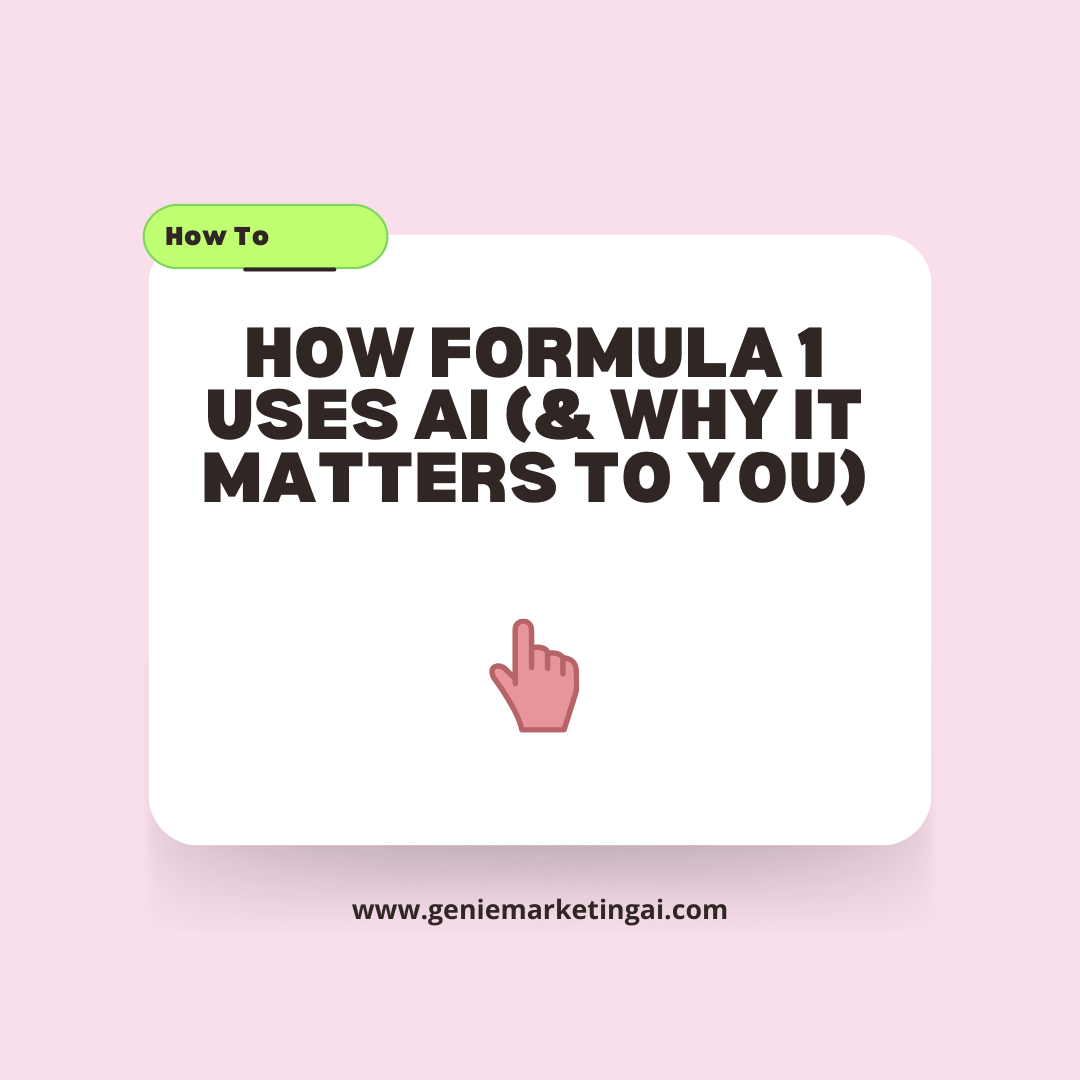Introduction
In Formula 1, victory and defeat are often decided by split-second decisions. A driver might win or lose a race by less than a blink of an eye. To gain this razor-thin edge, Formula 1 teams now rely on something more powerful than human reflexes: artificial intelligence (AI).
AI has exploded in motorsport, especially in Formula 1, where cars move at over 200 miles per hour and every detail matters. But here’s the exciting part: the AI technology used in F1 doesn’t stay on the racetrack. Many of these innovations eventually make their way into our everyday lives—helping our cars, cities, healthcare, and even the phones in our pockets.
In this article, we’ll explore how Formula 1 uses AI, from race strategy to car design, and why those same technologies could soon impact you.
The AI Revolution in Formula 1: Setting the Stage
Formula 1 has always been a sport of innovation. In the past, success came mainly from mechanical engineering—better engines, lighter materials, faster tires. Today, the real battleground is data science.
During a single race weekend, an F1 car generates more than 300 gigabytes of data. That’s like streaming over 100,000 songs. With so much information, teams needed AI to process it all in real time.
F1 is the perfect testing ground for AI because:
-
The sport moves at extreme speed.
-
Margins of victory are tiny.
-
Teams constantly seek a competitive edge.
This pressure makes F1 one of the fastest adopters of AI in the world.
Real-Time Race Strategy: AI as the Ultimate Co-Pilot
Keyword: F1 race strategy AI
Imagine trying to make hundreds of lightning-fast decisions while driving at 200 mph. That’s what Formula 1 drivers and their teams face each race. AI acts like an ultimate co-pilot, analyzing thousands of variables in real time:
-
Tire wear
-
Fuel consumption
-
Track temperature
-
Competitor strategies
-
Weather changes
With predictive modeling, AI helps teams decide the best time to pit for new tires or adjust strategy when rain is coming. For example, in recent seasons, AI-powered race strategy tools have predicted undercuts (pitting earlier than a rival to gain track position) with incredible accuracy.
But humans still matter. Engineers in mission control centers work hand-in-hand with AI systems. Together, they make final calls, blending data-driven predictions with human intuition.
Aerodynamics and Design: AI Reshaping the Cars
Aerodynamics—how air flows over the car—is everything in F1. A small tweak can add huge speed advantages. Traditionally, engineers spent months testing designs in wind tunnels.
Now, AI speeds up the process using machine learning and computational fluid dynamics (CFD). These algorithms simulate airflow digitally, running thousands of designs in days instead of months.
Some teams even use generative design, where AI creates car parts that no human would have imagined. These parts often look organic—like bone structures—but are incredibly strong and lightweight.
This approach saves time, money, and materials. Many AI-shaped components are already racing on today’s F1 cars.
Predictive Maintenance: Keeping Cars Running at 200+ MPH
F1 cars are masterpieces of engineering, but they’re also fragile. A single part failure can cost millions of dollars and end a race. To prevent this, teams use predictive maintenance powered by AI.
Every car is covered in sensors that monitor engines, brakes, suspension, and even tiny bolts. AI analyzes this data to predict when something might fail—before it happens.
For example, if a gearbox shows signs of overheating, AI can alert engineers to replace it before the next race. This not only improves safety but also saves teams huge amounts of money by avoiding catastrophic failures.
The same predictive maintenance technology is now being used in industries like aviation, manufacturing, and even personal cars.
Driver Performance and Safety: AI as the Guardian Angel
Formula 1 drivers push their bodies to the limit. They experience forces similar to fighter pilots and race for nearly two hours in extreme heat. AI acts as a guardian angel, helping protect their health and improve performance.
-
Biometric sensors track heart rate, oxygen levels, and fatigue.
-
G-force analysis shows how high-speed corners impact the body.
-
AI systems can even predict when a driver is at risk of losing focus.
In crashes, AI analyzes impact data in milliseconds to alert safety crews. It also helps design better helmets, barriers, and protective gear.
Beyond safety, AI studies driver behavior to suggest improvements, almost like a digital coach. It can point out stress patterns and help drivers train mentally for peak performance.
Fan Experience: AI Bringing You Closer to the Action
Formula 1 isn’t just about the teams—it’s also about the fans. AI is transforming how people watch and enjoy races.
-
Personalized content: AI recommends videos, highlights, and stats based on your favorite team or driver.
-
Real-time insights: During races, AI explains strategies, pit stops, and tire choices in simple terms for viewers.
-
Augmented reality (AR): Some broadcasts overlay live race data on-screen, giving fans a cockpit-like experience.
-
Fantasy F1 and betting apps: AI analyzes stats to help fans build fantasy teams or predict outcomes.
By making the sport easier to understand and more interactive, AI brings fans closer to the heart of the action.
Why F1’s AI Innovations Matter to Your Daily Life
You might wonder: “Cool, but what does this have to do with me?” The answer: a lot.
1. Automotive Industry
-
AI used in F1 race strategy is powering advanced driver assistance systems (ADAS) in everyday cars.
-
Predictive maintenance helps your car tell you when a part will fail.
-
AI-designed aerodynamics improve fuel efficiency.
2. Healthcare
-
Biometric monitoring from F1 inspires wearable health trackers.
-
Predictive analytics help doctors spot issues earlier.
-
Emergency response systems use F1-style AI to deploy help faster.
3. Manufacturing & Logistics
-
F1-style predictive maintenance keeps factories running smoothly.
-
Supply chain optimization ensures products arrive on time.
-
AI-powered quality control reduces defects.
4. Smart Cities
-
Traffic flow systems inspired by F1 AI reduce jams.
-
Energy grids are optimized like F1 pit strategies.
-
Emergency services use predictive AI for faster response.
In short: F1’s AI isn’t just about winning races. It’s about building technologies that touch millions of lives.
The Technology Transfer: How F1 Innovations Reach Consumers
So, how do F1 breakthroughs move into the real world? It happens through technology transfer.
F1 teams partner with car companies, universities, and tech firms. Together, they adapt racetrack innovations for consumer use.
For example:
-
F1’s carbon fiber materials are now used in road cars and airplanes.
-
Advanced safety systems first tested in F1 are now mandatory in many passenger cars.
Usually, the timeline is 5–10 years from track to consumer. F1 spends billions on research, and the rest of the world benefits.
Future Trends: What’s Next for AI in F1
The future of AI in Formula 1 looks even more exciting:
-
Autonomous racing: AI-controlled cars could test new limits.
-
Digital twins: Entire cars simulated virtually for testing.
-
Sustainable racing: AI helps optimize fuel, tires, and energy use for greener F1.
-
Fan interaction: Virtual reality lets fans feel like they’re in the cockpit.
-
Quantum computing: Could revolutionize simulations and strategies.
Getting Involved: How to Follow and Learn from F1’s AI Journey
You don’t need to be an engineer to get inspired by F1 AI. Here’s how you can follow and learn:
-
Educational courses: Many universities offer classes in motorsport technology.
-
Career paths: Engineering, data science, AI, and sports analytics are growing fields.
-
Open-source projects: Some F1-style datasets are available online for free.
-
Follow F1 tech news: Many teams share updates about their innovations.
By studying F1 AI, you can understand the future of technology before it arrives.
Formula 1 is more than a sport—it’s a laboratory for the future.
AI is transforming every part of F1: race strategy, car design, safety, fan experience, and beyond. But the story doesn’t end there. These innovations quickly transfer into everyday life, making our cars safer, our healthcare smarter, and our cities more efficient.
So next time you watch an F1 race, remember: you’re not just seeing who wins a trophy. You’re watching the future of technology unfold—at 200 miles per hour.


